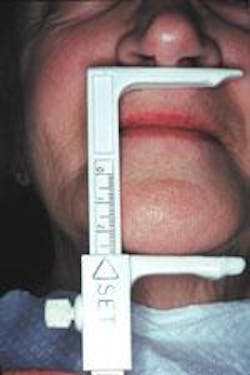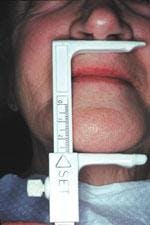A new dimension in craniometry
Joe Blaes, DDS
Pearl 1 — The Knebelman Craniometer by Craniometrics, Inc. I first wrote about this great instrument in June of 1996. Since then, it has simplified my practice and saved me countless hours. Guesswork and trial and error methods once were needed to determine the correct vertical dimension in fixed and removable prostho-dontics. Thanks to Dr. Stanley Knebel-man, you can identify the proper vertical dimension easily and accurately. You simply measure and record the distance between the external auditory meatus and the lateral border of the ocular orbit. Then reset the gauge to the craniometric adjustment. The gauge should fit snugly between the most anterior part of the undersurface of the mandible and the nasal spine with the teeth in occlusion. If it fits loosely, vertical dimension has been lost and can easily be restored. Although I never personally met him, we spent many hours on the telephone discussing the many applications of his invention and the many hours of research that led to the refinement of this instrument. Patients with severe headaches, TMJ pain, sleep apnea, and other symptoms traveled to Wynnewood, Penn. to be treated successfully by Dr. Knebelman. In 1986, he discovered a proportional relationship between landmarks in the skull that led him to develop and patent the Craniometer. Dr. Knebelman grew up in West Philadelphia, where his father, Dr. Abraham Knebelman, taught him to do lab work. He graduated from St. Joseph's College and received his dental degree from Temple University in 1947. In 1988, he founded Craniometrics, Inc. to market his device to other dentists. In the 1990s, he combined his method with Centerline Technology, a ball-bearing bite recorder system for centering the jaw horizontally that was developed by Hubert Goddard and Alan Deeley. This year, Dr. Knebelman and Deeley were granted a patent for the treatment of sleep apnea, using the Craniometer and the ball-bearing bite recorder. Dr. Knebelman was recently appointed dental consultant at the Sleep Disorders Center at Abington Memorial Hospital.
Sadly, Dr. Knebelman died on March 9th of cancer. He was 79. He is survived by his wife, three children, and four grandchildren. His son, Jim, and daughter, Cynthia, now manage Craniometrics. Thousands of dentists now rely on the Craniometer. It is easy to use and comes with an instructional video, illustrated directions, and on-going technical support. For more information, visit www.craniometer.com, or call (510) 653-1984 between 1:00 to 5:00 pm Pacific Time.
Pearl 2 — Gradia® Direct by GC America. One of the problems with the new micro hybrid composites is the vast array of shades and modifiers. Most of us use one shade of composite to restore anterior and posterior teeth. These new "kits" require us to "layer" shades and modifiers to match natural teeth shades. The ultimate goal is to provide our patients with teeth that look natural. The use of a direct composite resin is still the material of choice for many of the aesthetic problems that we face. These direct resins can give a beautiful restorative option that is usually conservative, less expensive, and can often be completed in one visit. The characteristics of the new composite resins now allow the dentist to create improved aesthetics. The natural shades and improved translucencies have made creating beautiful, lifelike restorations for our patients simpler and certainly more predictable. With the best light refractory index, opalescence, fluorescence, and translucency available, Gradia Direct makes it easy to create natural looking, multi-layer restorations with as little as one shade. The Gradia Direct composite resin system from GC America is a micro hybrid and is available in an anterior and posterior component. The Anterior system is comprised of 20 shades, allowing the user to create natural restorations that have excellent translucency. This allows the Gradia Direct system to blend with the existing tooth to provide excellent cosmetic results. The system is comprised of standard shades that include shades based on the vita shade guide; bleach colors, and cervical colors. The Inside special shades have greater opacity, while the Outside special shades have a high degree of translucency incorporated with colors needed to add vital characterization. The Gradia Direct Posterior system is comprised of six shades that allow you to create blended restorations in the posterior. This system has standard shades that correspond to the dentinal colors and Outside special shades that allow for placement of additional enamel qualities. Basically, you replace dentin with dentin shades (which are generally more opaque) and enamel with enamel shades (which are generally more translucent) to give you a natural-looking aesthetic restoration in the anterior or posterior. The system has excellent handling properties that allow for precise placement without slumping or excessive tackiness. Gradia Direct polishes to a high shine with minimal effort. Order from your dealer or visit www.gcamerica.com for more information.
Pearl 3 — Pre-Approval from CareCredit® Pre-approval is a common practice used in many other markets but is new to the dental industry. The same system of pre-approval now allows practices to know in advance whether CareCredit will approve most patients before the financial discussion begins. Practices can pre-approve patients before asking them to complete applications, which saves time and effort. Unlike a standard credit inquiry, the pre-approval process does not affect a patient's credit bureau report. Practices currently using the program find it to be a great addition. For more information, call CareCredit at (800) 300-3046, extension 4519.


